Social Determinants of Health among Adults with Diagnosed HIV Infection, 2018: Special Focus Profiles

The Special Focus Profiles highlight disparities of HIV diagnoses rates by SDH variables including income inequality and factors for special consideration in addressing health disparities that may be of particular interest to HIV prevention programs in state and local health departments.
Health Disparities
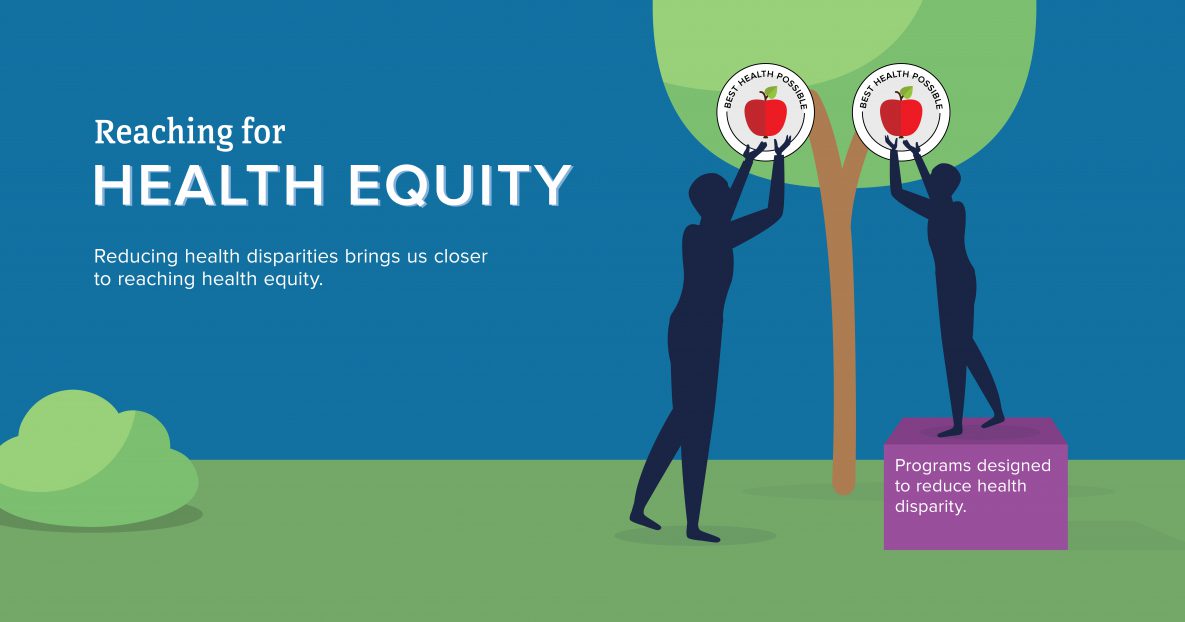
Health disparities are avoidable differences in the incidence, prevalence, mortality, and causes of a disease and the related adverse health conditions that exist among specific population groups. Reducing health disparities, achieving health equity, and improving the health of all U.S. population groups are major goals of public health.
Most health disparities are related to social determinants of health, the conditions in which people are born, grow, live, work, and age. Identification and awareness of differences among populations regarding health determinants and health outcomes are essential steps toward reducing health disparities. Most recent CDC reports show disparities by selected characteristics in many of the EHE initiative core indicators. Success in achieving the goal of the EHE initiative will be determined to some extent by how effectively federal, state, and local agencies and private organizations work with communities to eliminate health disparities among populations experiencing a disproportionate burden of disease, disability, and death.
This report includes two types of measures of disparities — absolute and relative. The absolute rate difference and the relative disparities (also known as, the diagnosis disparity ratio) were chosen because these measures are used by federal initiatives to measure progress in the social determinants of health and HIV diagnosis indicators. The absolute rate difference is a simple arithmetic difference that measures the absolute disparity between two groups for the same health status indicators (i.e., difference between the Black/African American rate and the white rate). The relative disparity, a diagnosis disparity ratio, measures the ratio of the difference between the group rate and the overall population rate to the overall rate. The disparities of HIV diagnoses rates by the SDH variables can be viewed as 2-fold: 1) the rate disparities (i.e., absolute disparities) between races/ethnicities by sex at birth, and 2) the relative disparity gap narrowing or widening as SDH variable levels increase or decrease (i.e., the ratio increases as the difference widens between a selected group and the overall population and decreases as the difference narrows) (Table 1).
Poverty, by Race/Ethnicity
Among males residing in census tracts with the lowest poverty, HIV diagnosis rates in 2018 among Blacks/African Americans (45.9) and Hispanics/Latinos (26.6) were 7.6 times and 4.4 times, respectively, as high as the rate for whites (6.0) (Figure 13 and Table 1). Among males residing in census tracts with the highest poverty, Blacks/African Americans (83.8) and Hispanics/Latinos (43.5) were 5.3 times and 2.7 times, respectively, as high as the rate for whites (16.0). The Black/African American-white and Hispanic/Latino-white relative disparities increased by 45% and 62%, respectively, as percentages of poverty decreased. Whereas, the Black/African American-white and Hispanic/Latino-white absolute disparities were wider (or more disparate) in the highest poverty areas than in the lowest poverty areas.
Figure 13. Disparities of diagnoses of HIV infection among adult males, by race/ethnicity and poverty status, 2018—census tract level, United States and Puerto Rico
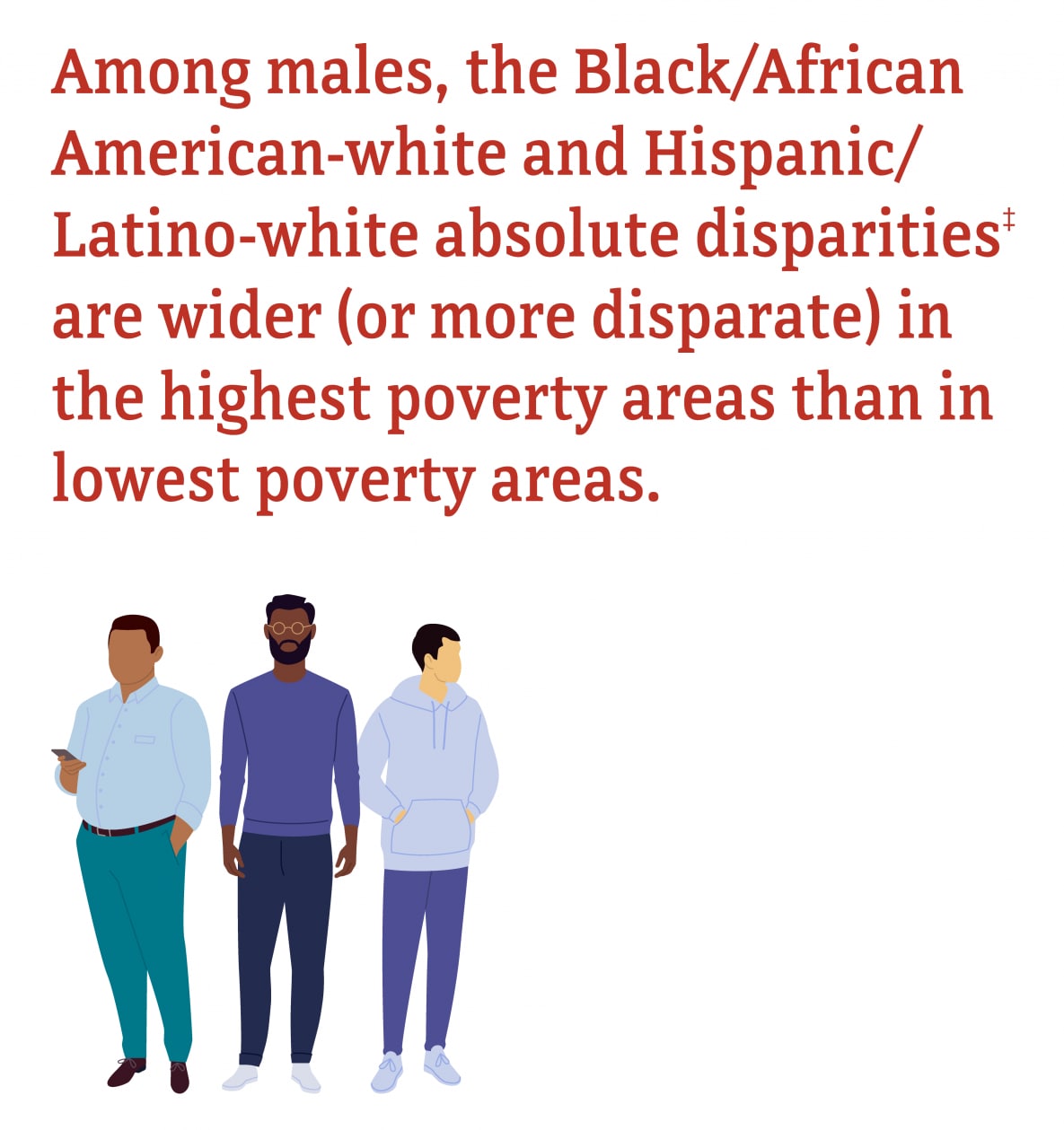
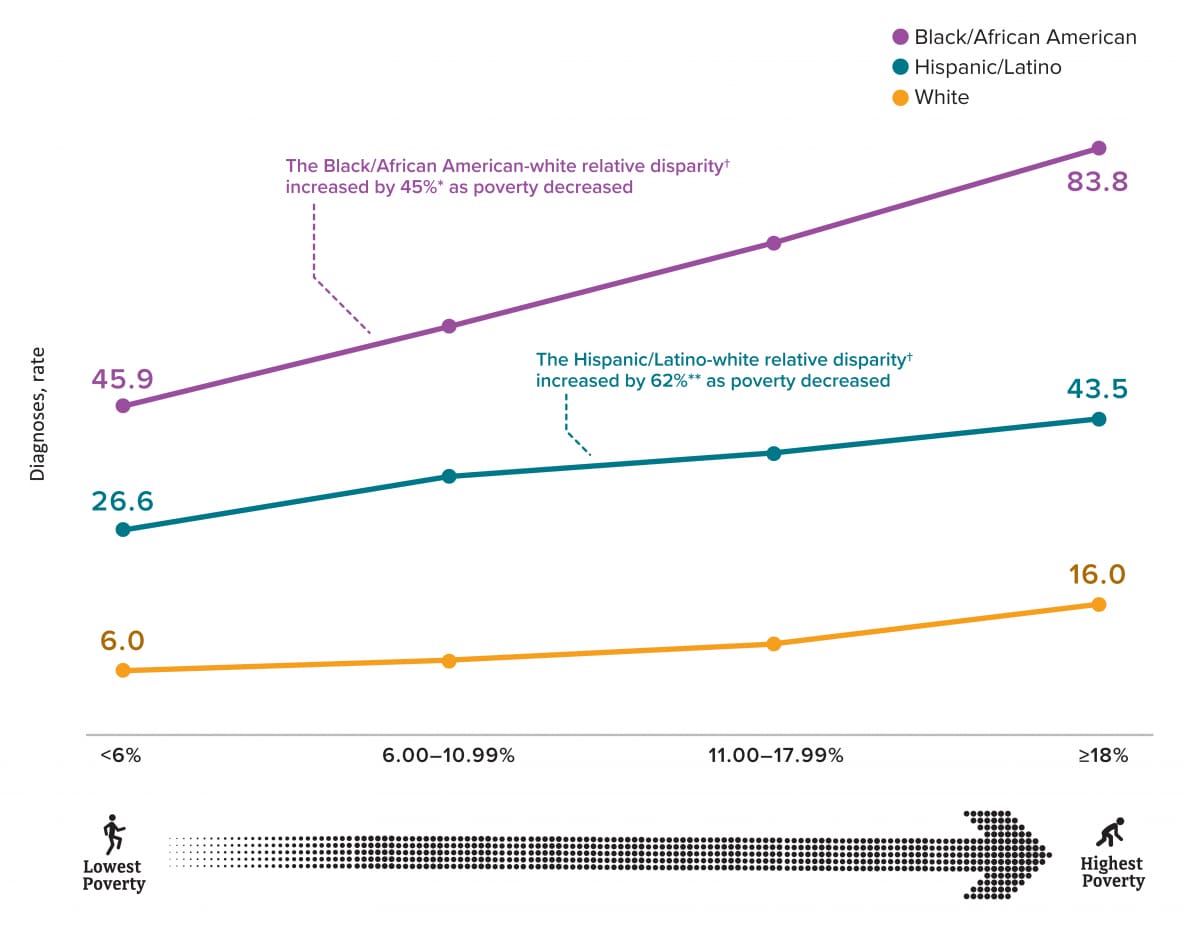
‡absolute disparity measures the difference between a group with the lowest rate and the group with the highest rate.
†relative disparity measures the ratio of the difference between the group rate and the overall population rate to the overall rate.
*45% increase is the lowest poverty disparity (45.9/6.0) compared to the highest poverty disparity (83.8/16.0).
**62% increase is the lowest poverty disparity (26.6/6.0) compared to the highest poverty disparity (43.5/16.0).
Among females residing in census tracts with the lowest poverty, HIV diagnosis rates among Blacks/African Americans (15.3) and Hispanics/Latinos (3.1) were 21.3 times and 4.3 times, respectively, as high as the rate for whites (0.7) (Figure 14 and Table 1). Among females residing in census tracts with the highest poverty, HIV diagnosis rates among Blacks/African Americans (25.0) and Hispanics/Latinos (7.3) were 7.0 times and 2.0 times, respectively, as high as the rate for whites (3.6). The Black/African American-white and Hispanic/Latino-white relative disparities increased by 207% and 110%, respectively, as percentages of poverty decreased. Whereas, the Black/African American-white and Hispanic/Latino-white absolute disparities were wider (or more disparate) in the highest poverty areas than in lowest poverty areas.
Figure 14. Disparities of diagnoses of HIV infection among adult females, by race/ethnicity and poverty status, 2018—census tract level, United States and Puerto Rico
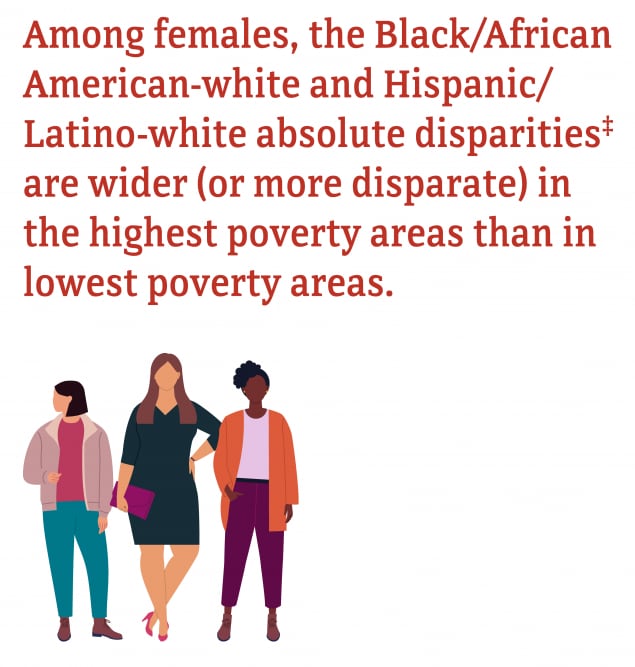
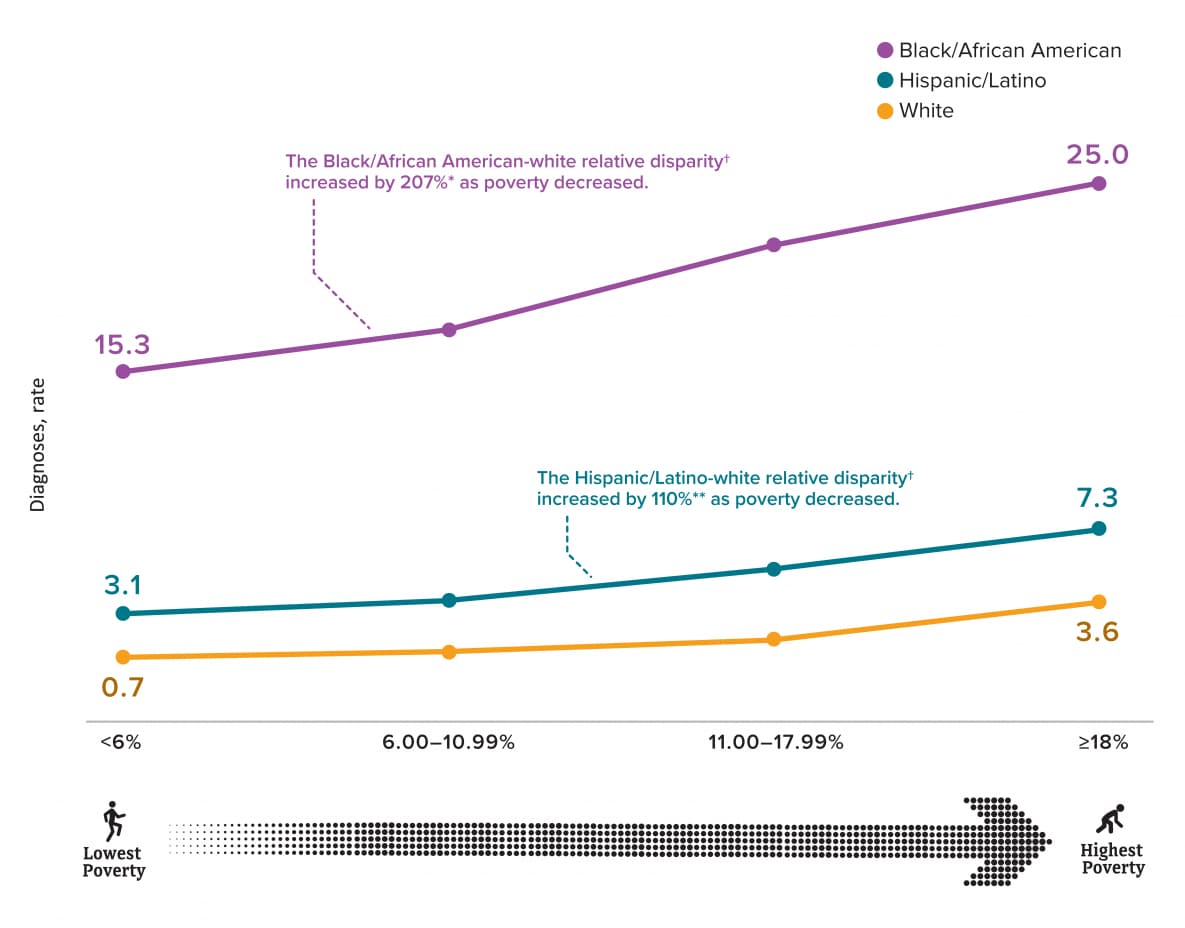
‡absolute disparity measures the difference between a group with the lowest rate and the group with the highest rate.
†relative disparity measures the ratio of the difference between the group rate and the overall population rate to the overall rate.
*207% increase is the lowest poverty disparity (15.3/0.7) compared to the highest poverty disparity (25.0/3.6).
**110% increase is the lowest poverty disparity (3.1/0.7) compared to the highest poverty disparity (7.3/3.6).
Education, by Race/Ethnicity
Among males residing in census tracts with the highest education, HIV diagnosis rates among Blacks/African Americans (63.1) and Hispanics/Latinos (39.0) were 8.2 times and 5.1 times, respectively, as high as the rate for whites (7.7) (Figure 15 and Table 1). Among males residing in census tracts with the lowest education, HIV diagnosis rates among Blacks/African Americans (74.9) and Hispanics/Latinos (38.2) were 5.0 times and 2.6 times, respectively, as high as the rate for whites (14.9). The Black/African American-white and the Hispanic/Latino-white relative disparities increased by 63% and 98%, respectively, as percentages of education increased. Whereas, the Black/African American-white absolute disparity was narrower (or less disparate) and Hispanic/Latino-white absolute disparity was wider (or more disparate) in the highest education areas than in the lowest education areas.
Figure 15. Disparities of diagnoses of HIV infection among adult males, by race/ethnicity and education status, 2018—census tract level, United States and Puerto Rico
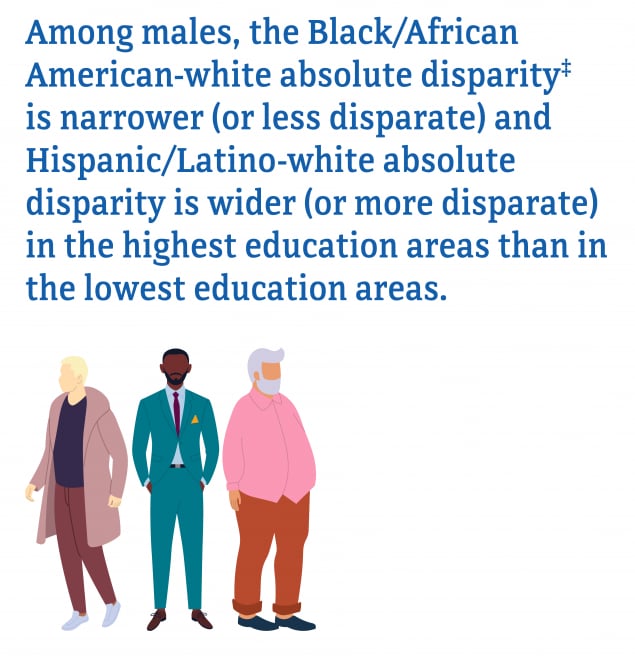
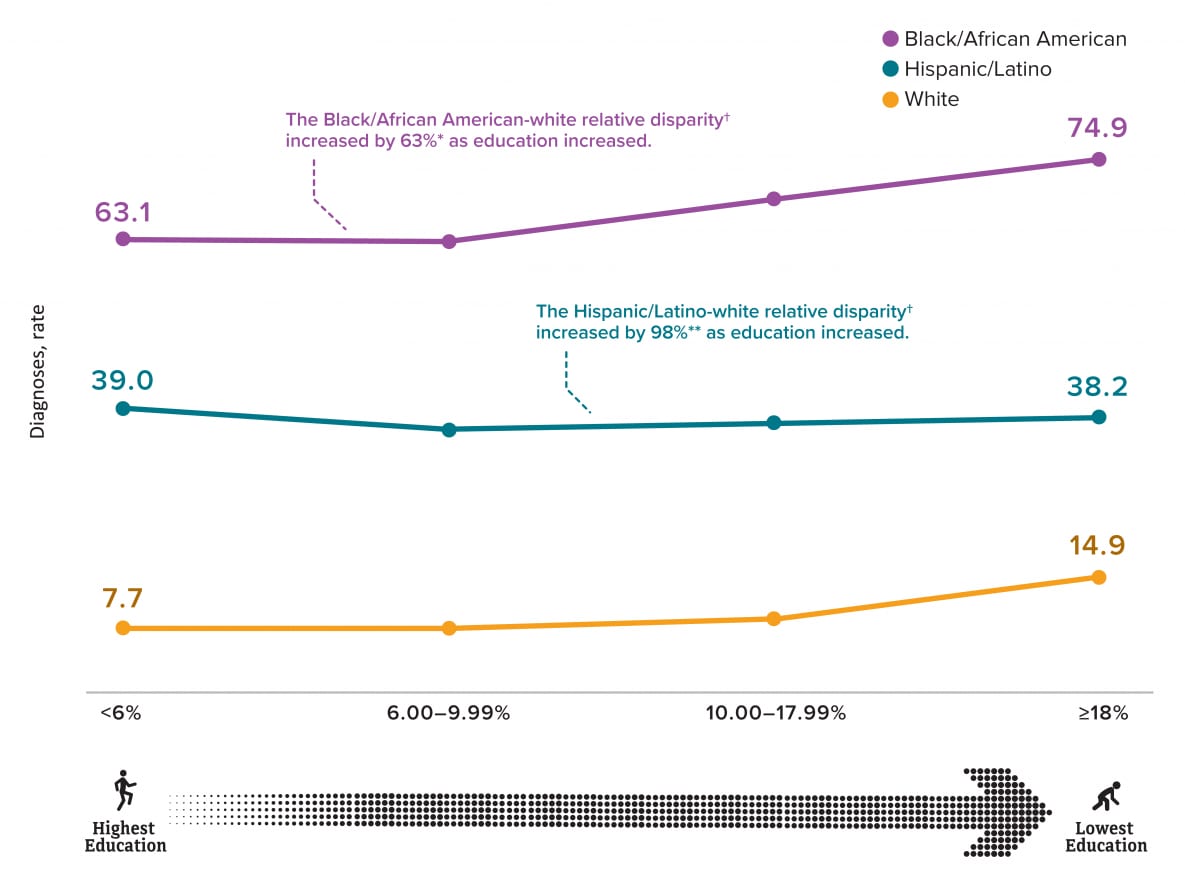
‡absolute disparity measures the difference between a group with the lowest rate and the group with the highest rate.
†relative disparity measures the ratio of the difference between the group rate and the overall population rate to the overall rate.
*63% increase is the lowest education disparity (74.9/14.9) compared to the highest education disparity (63.1/7.7).
**98% increase is the lowest education disparity (38.2/14.9) compared to the highest education disparity (39.0/7.7).
Among females residing in census tracts with the highest education, HIV diagnosis rates among Blacks/African Americans (15.1) and Hispanics/Latinos (3.3) was 20.1 times and 4.4 times, respectively, as high as the rate for whites (0.8) (Figure 16 and Table 1). Among females residing in census tracts with the lowest education, HIV diagnosis rates among Blacks/African Americans (26.2) and Hispanics/Latinos (6.4) were 6.9 times and 1.7 times, respectively, as high as the rate for whites (3.8). The Black/African American-white and Hispanic/Latino-white relative disparities increased by 193% and 164%, respectively, as percentages of education increased. Whereas, the Black/African American-white absolute disparity was wider (or more disparate) and Hispanic/Latino-white absolute disparity was similar in the lowest education areas than in the highest education areas.
Figure 16. Disparities of diagnoses of HIV infection among adult females, by race/ethnicity and education status, 2018—census tract level, United States and Puerto Rico
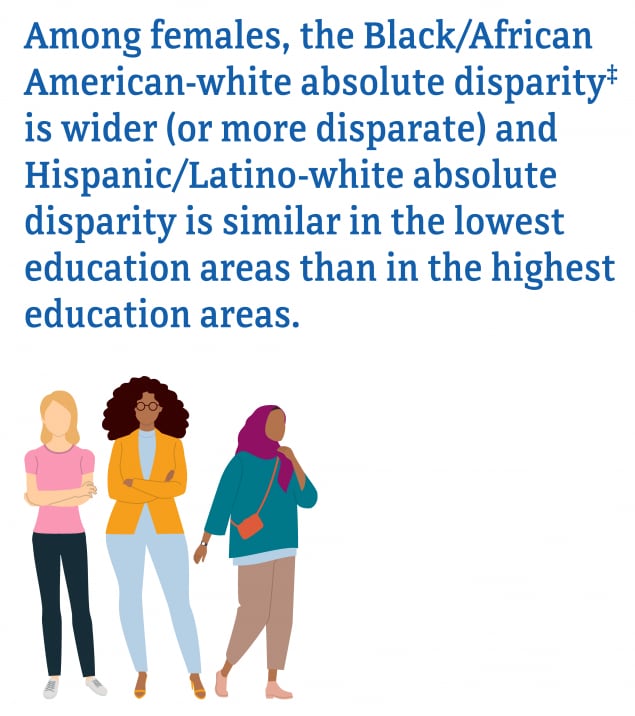
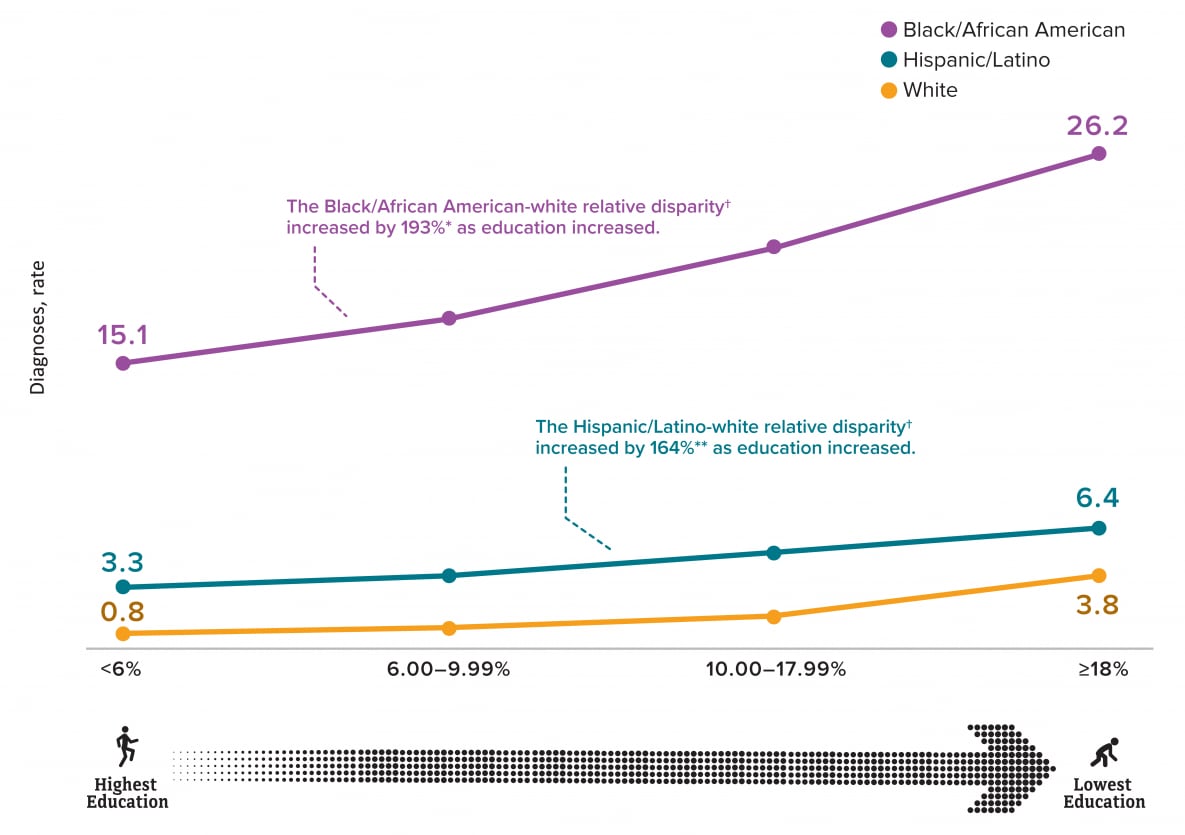
‡absolute disparity measures the difference between a group with the lowest rate and the group with the highest rate.
†relative disparity measures the ratio of the difference between the group rate and the overall population rate to the overall rate.
*193% increase is the lowest education disparity (26.2/3.8) compared to the highest education disparity (15.1/0.8).
**164% increase is the lowest education disparity (6.4/3.8) compared to the highest education disparity (3.3/0.8).
Income, by Race/Ethnicity
Among males residing in census tracts with the lowest income, HIV diagnosis rates among Blacks/African Americans (82.6) and Hispanics/Latinos (42.9) was 3.0 times and 5.8 times, respectively, as high as the rate for whites (14.4) (Figure 17 and Table 1). Among males residing in census tracts with the highest income, HIV diagnosis rates among Blacks/African Americans (49.8) and Hispanics/Latinos (31.5) were 7.2 times and 4.6 times, respectively, as high as the rate for whites (6.9). Whereas, the Black/African American-white and Hispanic/Latino-white absolute disparities were wider (or more disparate) in the lowest income areas than in the highest income areas.
Figure 17. Disparities of diagnoses of HIV infection among adult males, by race/ethnicity and income level, 2018—census tract level, United States and Puerto Rico
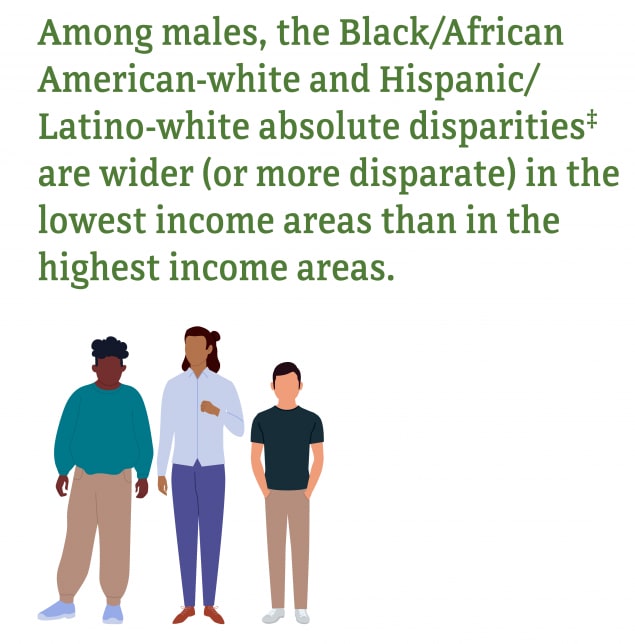
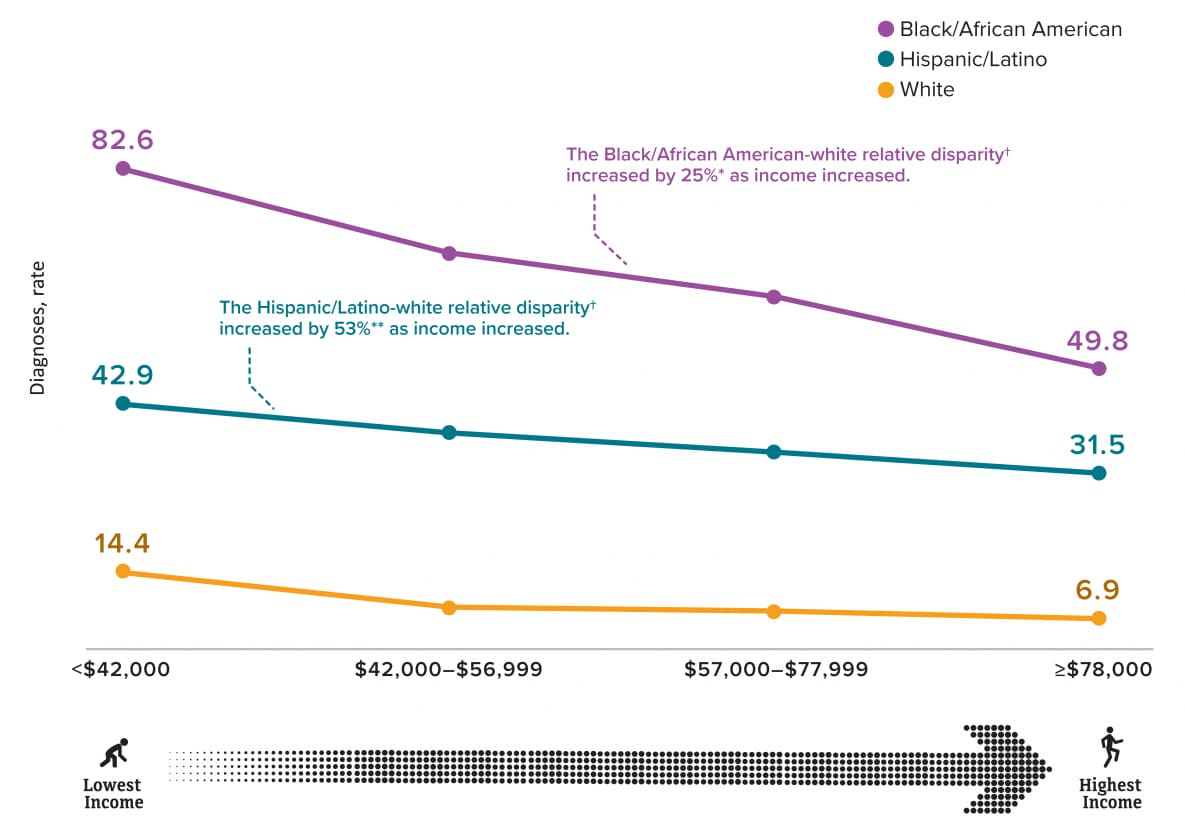
‡absolute disparity measures the difference between a group with the lowest rate and the group with the highest rate.
†relative disparity measures the ratio of the difference between the group rate and the overall population rate to the overall rate.
*25% increase is the lowest income disparity (82.6/14.4) compared to the highest income disparity (49.8/6.9).
**53% increase is the lowest income disparity (42.9/14.4) compared to the highest income disparity (31.5/6.9).
Among females residing in census tracts with the lowest income, HIV diagnosis rates among Blacks/African Americans (24.8) and Hispanics/Latinos (7.6) was 7.5 times and 2.3 times, respectively, as high as the rate for whites (3.3) (Figure 18 and Table 1). Among females residing in census tracts with the highest income, HIV diagnosis rates among Blacks/African Americans (16.4) and Hispanics/Latinos (3.2) were 21.2 times and 4.1 times, respectively, as high as the rate for whites (0.8). The Black/African American-white and Hispanic/Latino-white relative disparities increased by 182% and 77%, respectively, as percentages of income increased. Whereas, the Black/African American-white and Hispanic/Latino-white absolute disparities were wider (or more disparate) in the lowest income areas than in the highest income areas.
Figure 18. Disparities of diagnoses of HIV infection among adult females, by race/ethnicity and income level, 2018—census tract level, United States and Puerto Rico
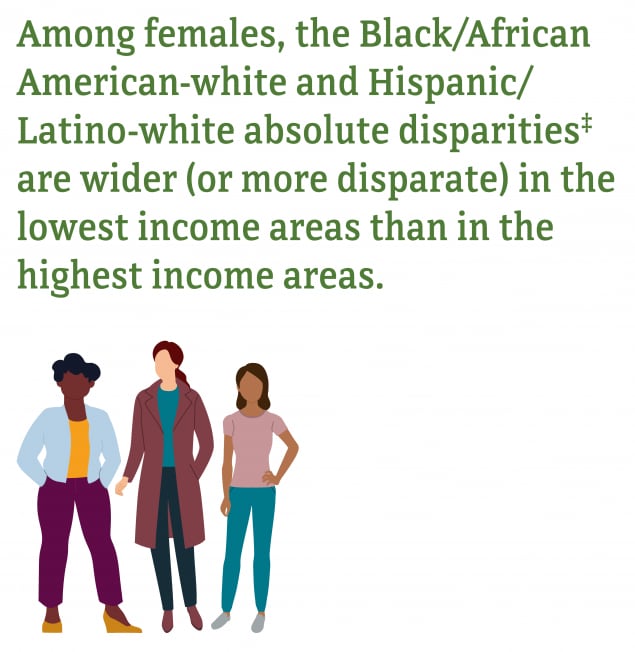
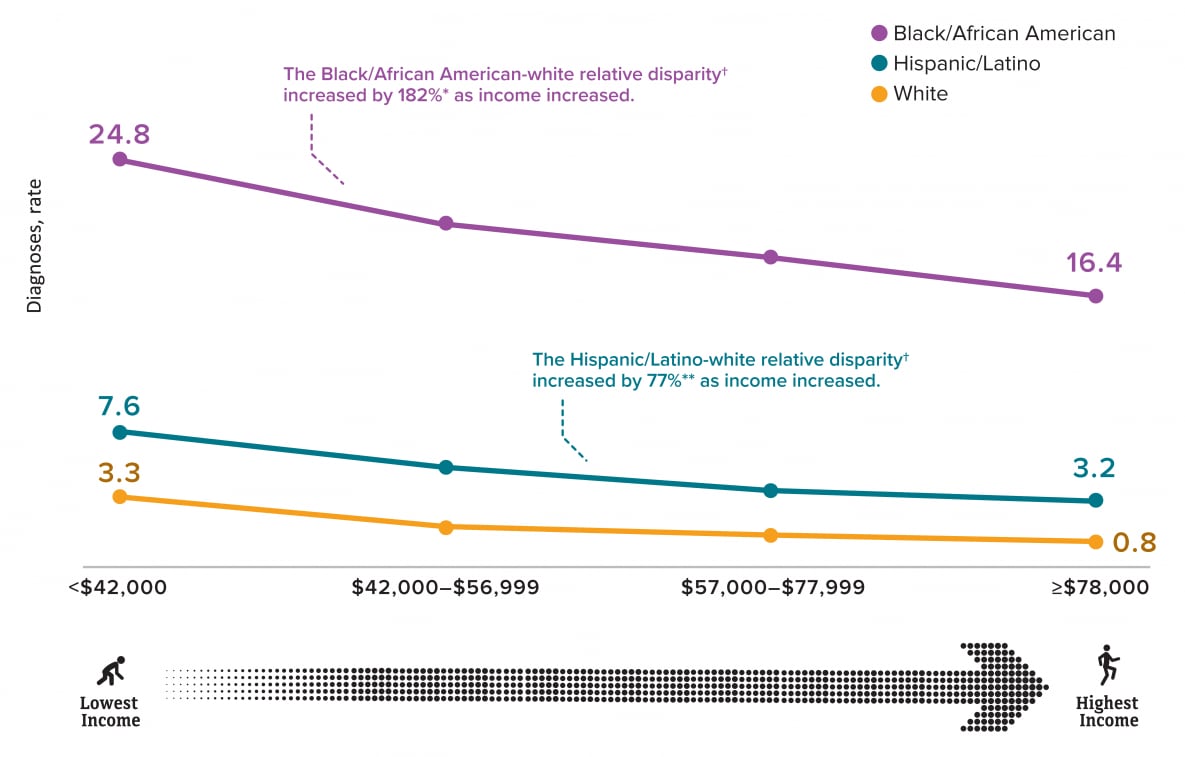
‡absolute disparity measures the difference between a group with the lowest rate and the group with the highest rate.
†relative disparity measures the ratio of the difference between the group rate and the overall population rate to the overall rate.
*182% increase is the lowest income disparity (24.8/3.3) compared to the highest income disparity (16.4/0.8).
**77% increase is the lowest income disparity (7.6/3.3) compared to the highest income disparity (3.2/0.8).
Health Insurance Coverage, by Race/Ethnicity
Among males residing in census tracts with the highest health insurance coverage, HIV diagnosis rates among Blacks/African Americans (50.1) and Hispanics/Latinos (28.3) was 8.5 times and 4.8 times, respectively, as high as the rate for whites (5.9) (Figure 19 and Table 1). Among males residing in census tracts with the lowest health insurance coverage, HIV diagnosis rates among Blacks/African Americans (88.6) and Hispanics/Latinos (43.0) were 5.5 times and 2.7 times, respectively, as high as the rate for whites (16.1). The Black/African American-white and Hispanic/Latino-white relative disparities increased by 54% and 79%, respectively, as percentages of health insurance coverage increased. Whereas, the Black/African American-white and the Hispanic/Latino-white absolute disparities were wider (or more disparate) in areas with the lowest health insurance coverage than in areas with the highest health insurance coverage.
Figure 19. Disparities of diagnoses of HIV infection among adult males, by race/ethnicity and health insurance coverage, 2018—census tract level, United States and Puerto Rico
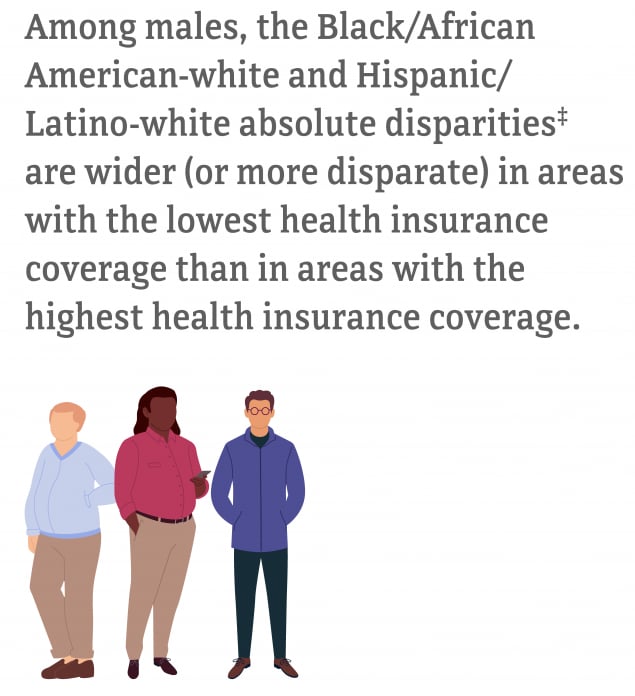
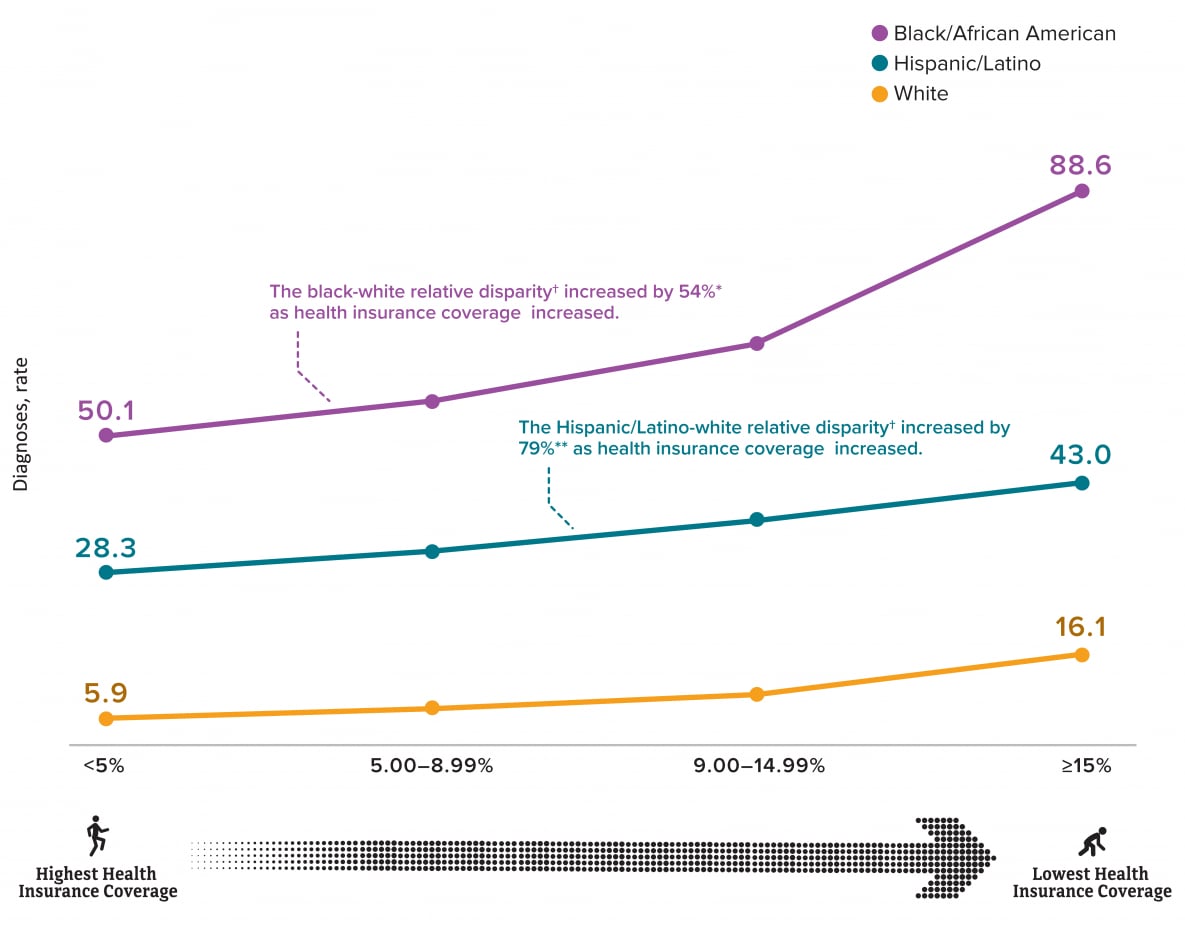
‡absolute disparity measures the difference between a group with the lowest rate and the group with the highest rate.
†relative disparity measures the ratio of the difference between the group rate and the overall population rate to the overall rate.
*54% increase is the lowest health insurance coverage (88.6/16.1) compared to the highest health insurance coverage (50.1/5.9).
**79% increase is the lowest health insurance coverage (43.0/16.1) compared to the highest health insurance coverage (28.3/5.9).
Among females residing in census tracts with the highest health insurance coverage, HIV diagnosis rates among Blacks/African Americans (17.2) and Hispanics/Latinos (3.6) was 4.7 times and 22.1 times, respectively, as high as the rate for whites (0.8) (Figure 20 and Table 1). Among females residing in census tracts with the lowest health insurance coverage, HIV diagnosis rates among Blacks/African Americans (28.1) and Hispanics/Latinos (6.5) were 8.2 times and 1.9 times, respectively, as high as the rate for whites (3.5). Whereas, the Black/African American-white absolute disparity was wider (or more disparate) and the Hispanic/Latino-white absolute disparity was similar in areas with the lowest health insurance coverage than in areas with the highest health insurance coverage.
Figure 20. Disparities of diagnoses of HIV infection among adult males, by race/ethnicity and health insurance coverage, 2018—census tract level, United States and Puerto Rico
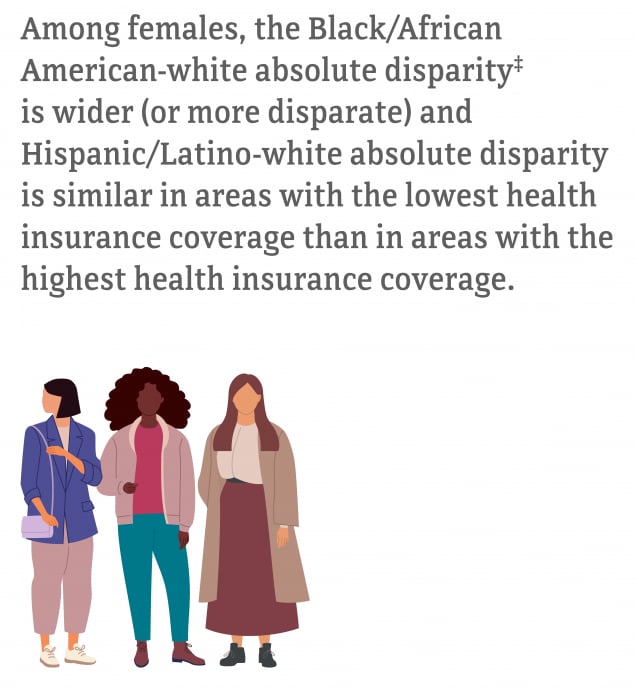
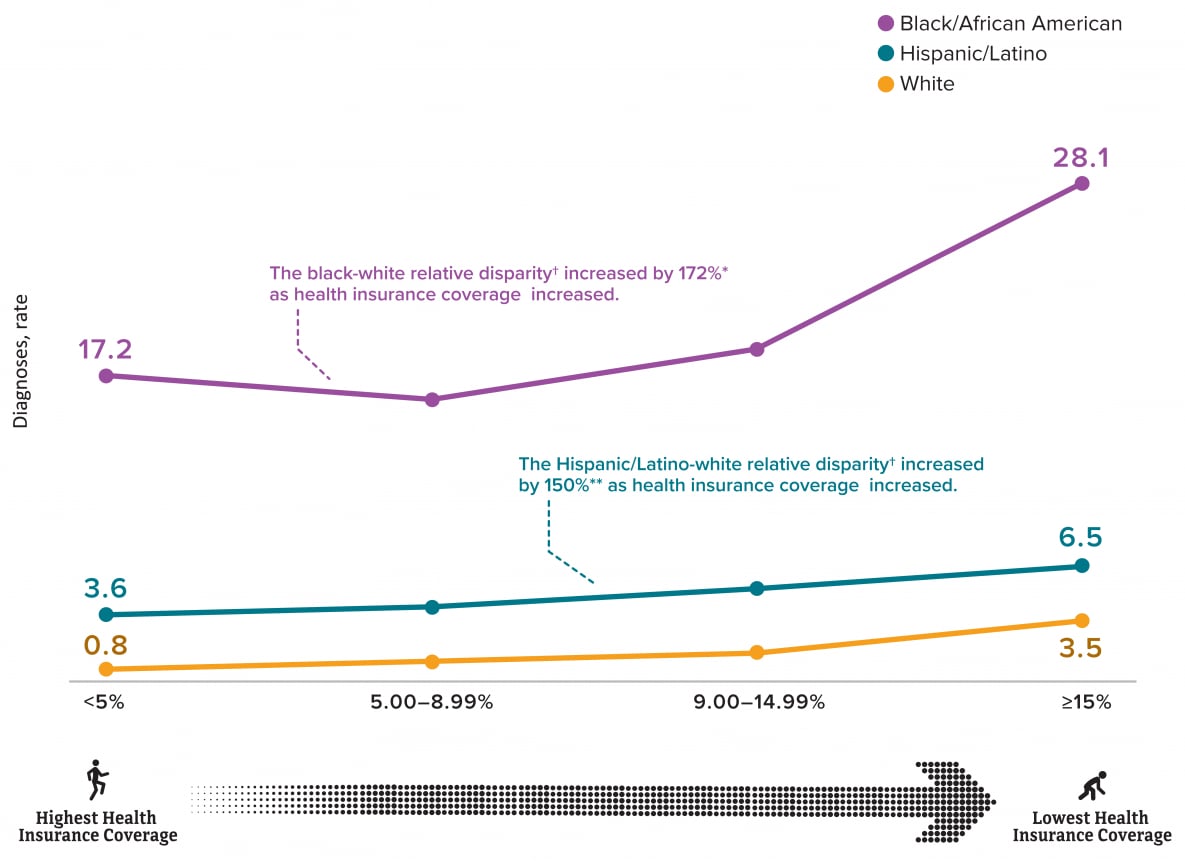
‡absolute disparity measures the difference between a group with the lowest rate and the group with the highest rate.
†relative disparity measures the ratio of the difference between the group rate and the overall population rate to the overall rate.
*172% increase is the lowest health insurance coverage (28.1/3.5) compared to the highest health insurance coverage (17.2/0.8).
**150% increase is the lowest health insurance coverage (6.5/3.5) compared to the highest health insurance coverage (3.6/0.8).
Income Inequality (Gini Index)
Poor health and income inequality go hand-in-hand. Income inequality and socioeconomic deprivation are 2 key socioeconomic determinants of HIV diagnosis and care outcomes. High levels of income inequality negatively affect the health of even the affluent, mainly because income inequality reduces social cohesion which leads to more stress, fear, and insecurity [5].
This report uses the Gini index to measure income inequality. The Gini index summarizes the dispersion of income across the entire income distribution. The Gini index ranges from 0 or 0%, indicating perfect equality (i.e., lowest income inequality—where all households have an equal share of income), to 1 or 100%, perfect inequality (i.e., highest income inequality—where only 1 household has all the income and the rest have none).
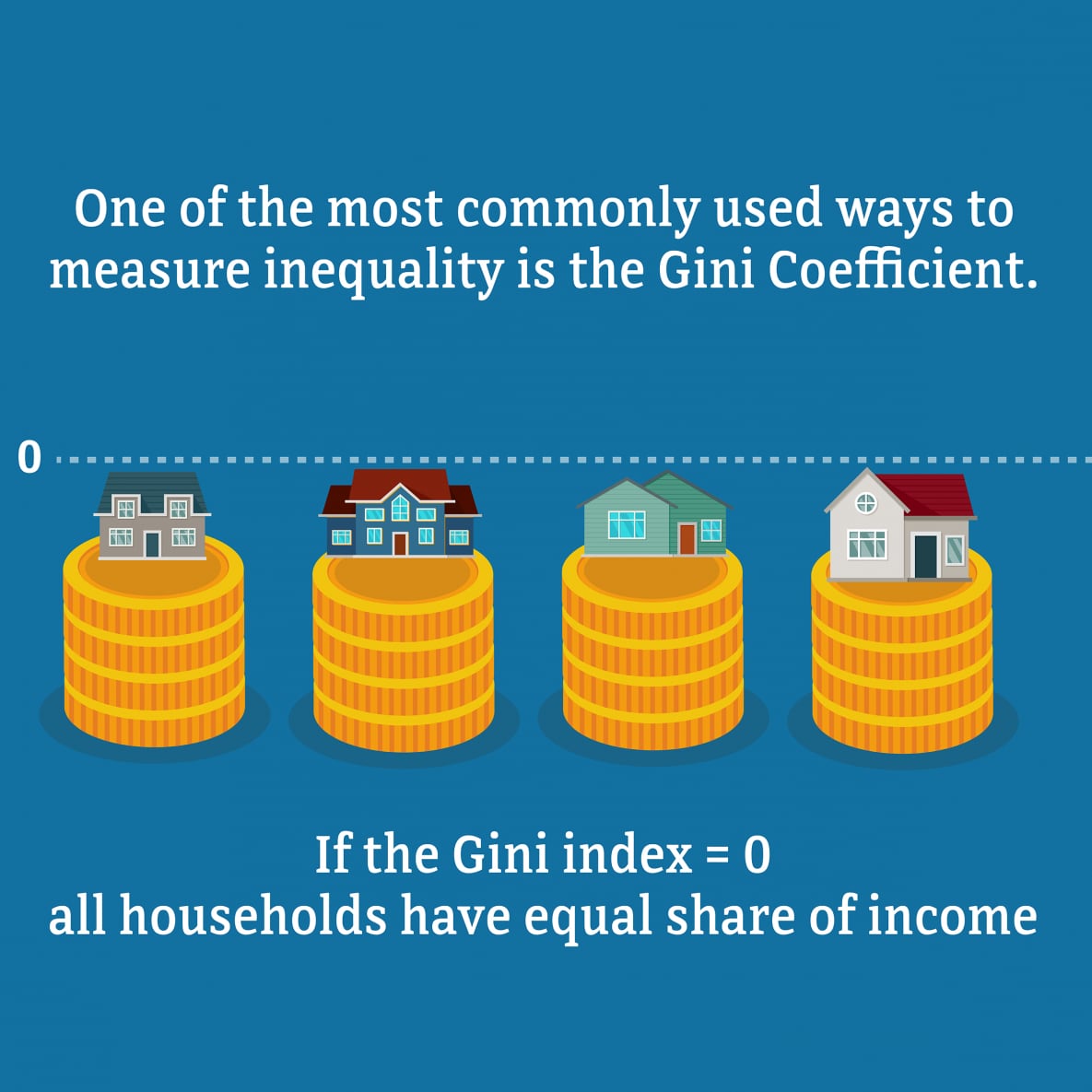
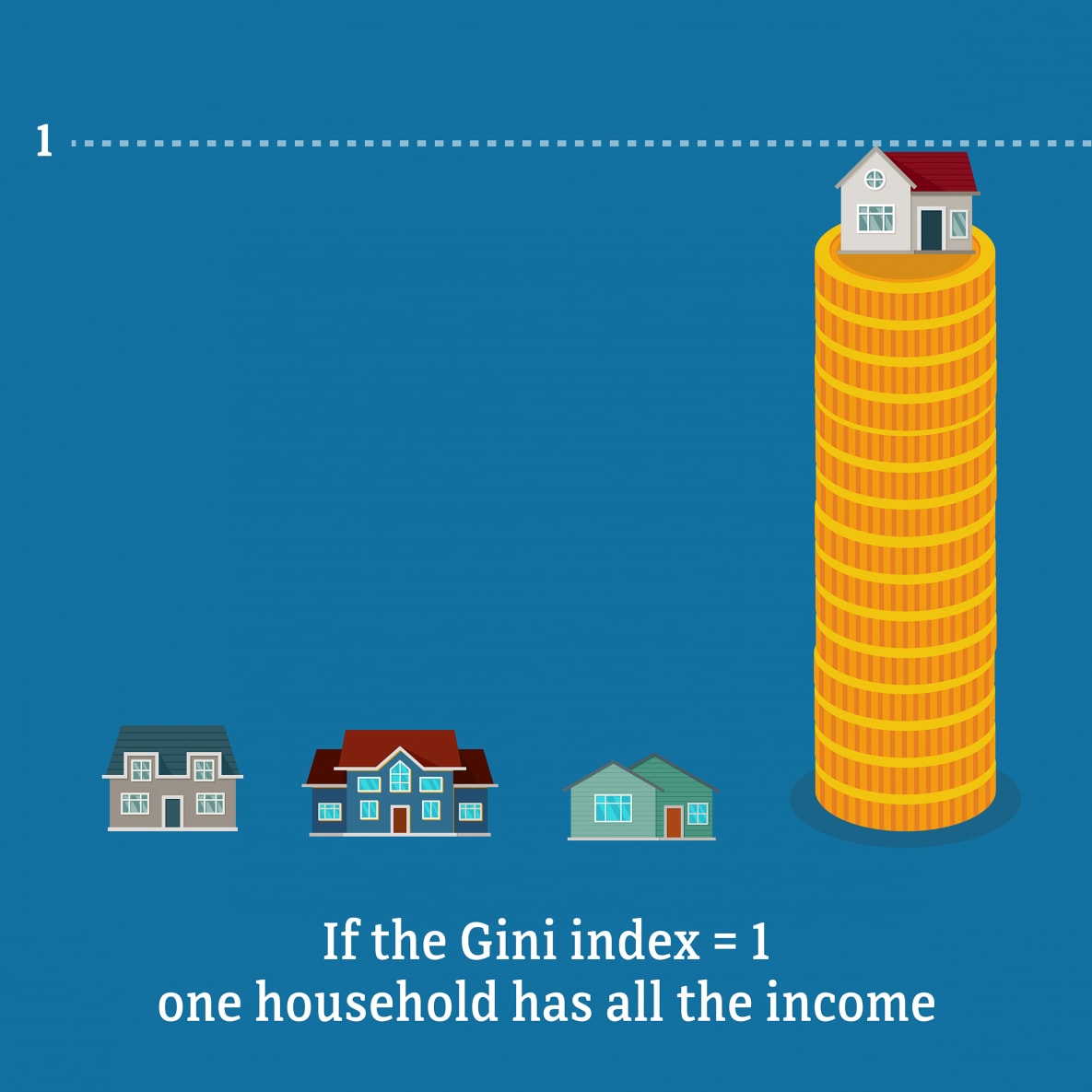
Income Inequality, by Sex at Birth
The highest HIV diagnosis rate for males (28.9) and for females (6.6) were among those who lived in census tracts where income inequality was 46% or more. For both sexes, the rate of HIV diagnoses increased as the percentages of income inequality increased (Table 1).
Income Inequality, by Sex at Birth and Age Group
Persons who lived in census tracts where income inequality was 46% or more accounted for the highest HIV diagnoses rates for both sexes in all age groups (Figure 21 and Table 2).
Figure 21. Diagnoses of HIV infection among adults, race/ethnicity, sex at birth, and Gini index, 2018—census tract level, United States and Puerto Rico

Note. Hispanics/Latinos can be of any race
Income Inequality, by Sex at Birth and Race/Ethnicity
Persons who lived in census tracts where income inequality was 46% or more accounted for the highest HIV diagnosis rates for both sexes in all racial/ethnic groups (Figure 22 and Table 1). Please use caution when interpreting data for American Indians/Alaska Natives and Native Hawaiian/other Pacific Islanders; most rates are based on small case counts.
Figure 22. Diagnoses of HIV infection among adults, age group, sex at birth, and Gini index, 2018—census tract level, United States and Puerto Rico

Income Inequality, by Transmission Category
Persons who lived in census tracts where income inequality was 46% or more accounted for the largest percentage of HIV diagnoses for both sexes and in all transmission categories (Figure 23 and Table 3).
Figure 23. Diagnoses of HIV infection among adults, by transmission category, sex at birth, and Gini index, 2018—census tract level, United States and Puerto Rico
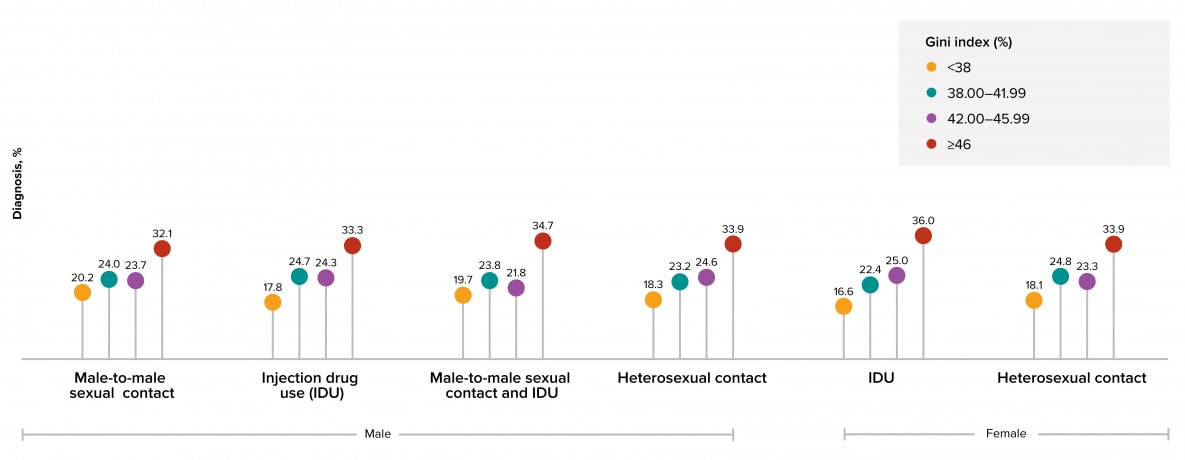
Note: Data have been statistically adjusted to account for missing transmission category. See Data Tables, Definitions, and Acronyms for more information on transmission categories.
Income Inequality, by Area of Residence
Persons who lived in census tracts where income inequality was 46% or more accounted for the largest percentage of HIV diagnoses; the areas with the highest rates of HIV diagnoses were the District of Columbia (total, 39.9; males, 65.9; females, 18.1), followed by Georgia (total, 33.2; females, 15.1) and Florida for males (53.2) (Table 8). Use caution when comparing the rates of diagnoses for the District of Columbia to the rates for states.
A Closer Look at Income Inequality

Income inequality has increased steadily in the United States since the 1970s. Disparities in income by sex and race/ethnicity persist and, in some cases, are greater than in 1970 [6]. Many factors— education, being foreign-born or immigrant status, historical legacy and impact of discrimination—are key components of income equality. Many of these same factors contribute to disparities in HIV diagnoses, although, it is important to recognize the sex and race/ethnicity components that contribute to this disparity. The following section takes a closer look at income inequality among persons with diagnosed HIV infection by sex and race/ethnicity.
Income Inequality, by Sex at Birth
Among those residing in census tracts with the highest income inequality, the HIV diagnoses rate among males (28.9) was 4.4 times as high as the rate for females (6.6); and in census tracts with the lowest income inequality, the diagnoses rate among males (17.2) was 4.9 times as high as the rate for females (3.5) (Figure 24 and Table 1). The male-female HIV disparity remained similar among those residing in census tracts with the lowest income inequality compared to those with the highest income inequality.
Figure 24. Disparities of diagnoses of HIV infection among adults, by sex at birth and Gini index, 2018—census tract level, United States and Puerto Rico
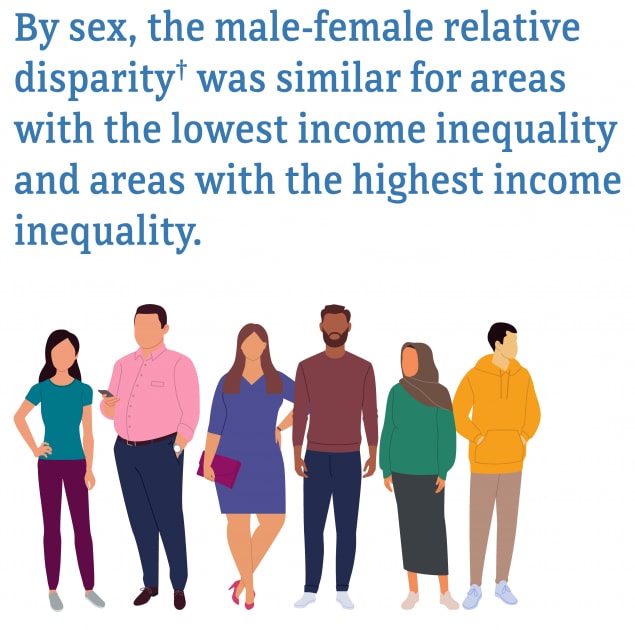
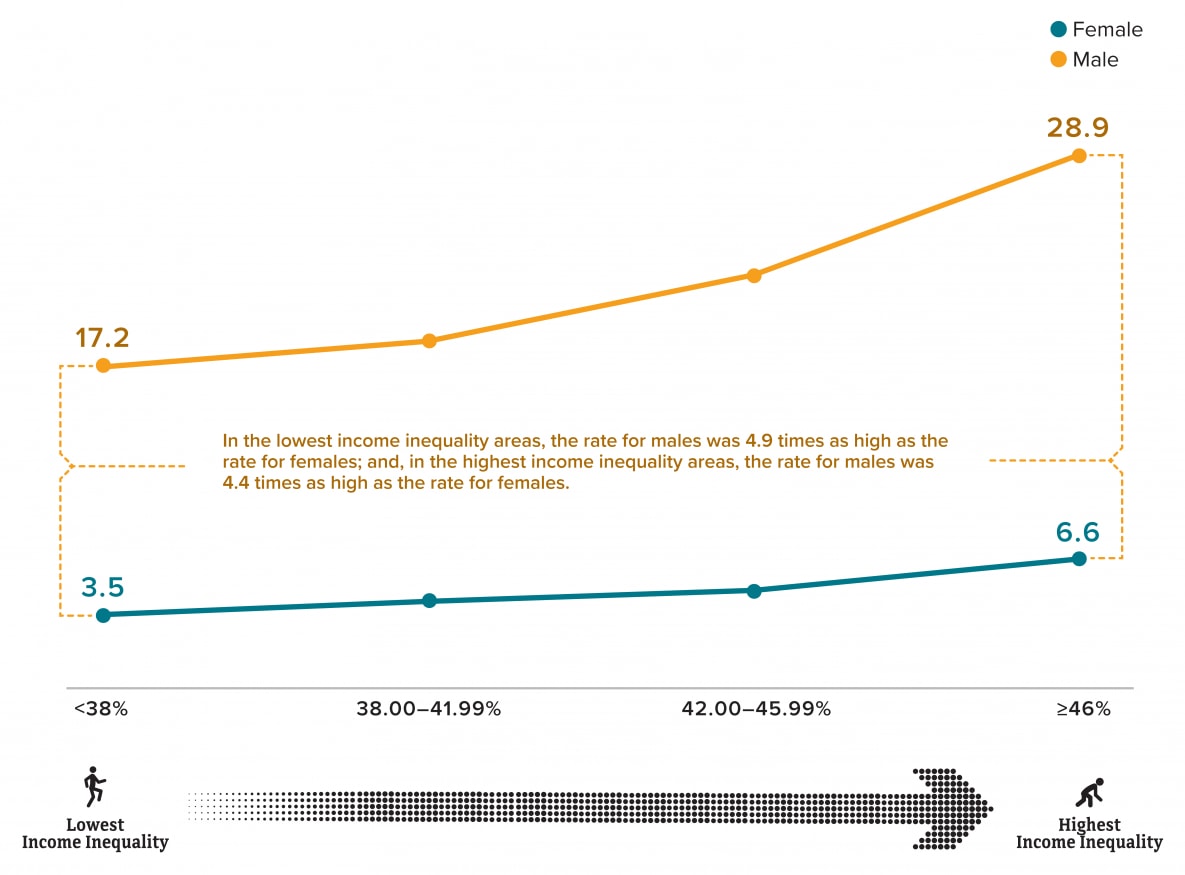
Income Inequality, by Race/Ethnicity
Disparities in HIV diagnoses rates by race/ethnicity persist regardless of income inequality. Among males residing in census tracts with the highest income inequality, the rate of diagnoses among Blacks/African Americans (80.0) was 6.9 times as high as the rate for whites (11.7); whereas, in census tracts with the lowest income inequality, the rate of diagnoses among Blacks/African Americans (58.3) was 7.6 times as high as the rate for whites (7.7) (Figure 25 and Table 1). That is, the Black/African American-white HIV disparity was slightly wider among those residing in census tracts with the lowest income inequality compared to those with the highest income inequality. The HIV diagnosis rate for Hispanics/Latinos was 3.9 times as high as the rate for whites for those residing in census tracts with both lowest and highest income inequality – indicating that the Hispanic/Latino-white HIV disparity remained similar among those residing in census tracts with the lowest income inequality compared to those with the highest income inequality.
Figure 25. Disparities of diagnoses of HIV infection among adult males, by race/ethnicity and Gini index, 2018—census tract level, United States and Puerto Rico
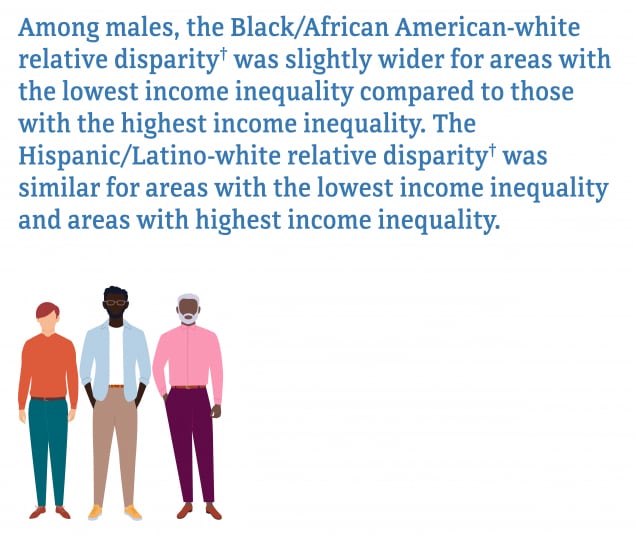
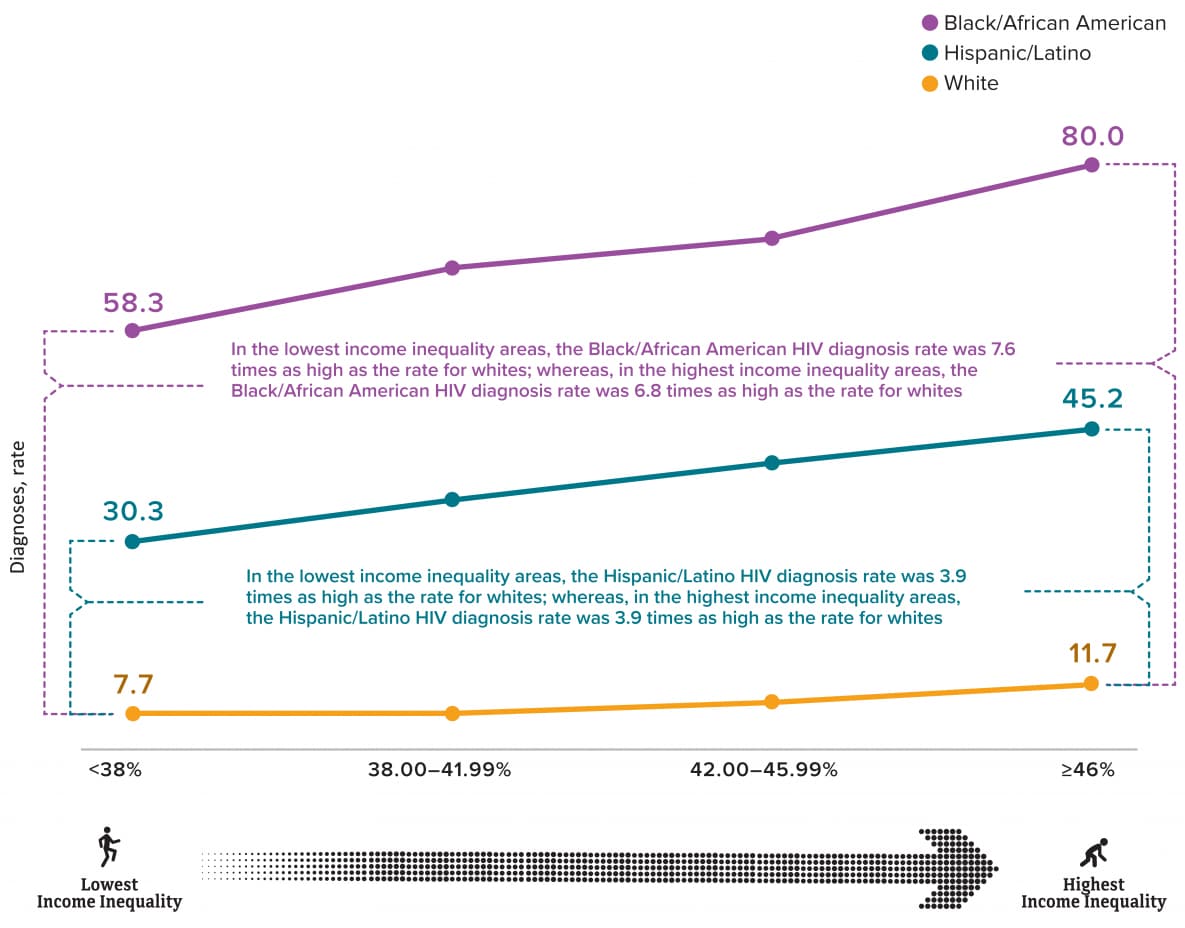
†relative disparity measures the ratio of the difference between the group rate and the overall population rate to the overall rate.
Among females residing in census tracts with the highest income inequality, the rate of diagnoses among Blacks/African Americans (23.2) was 12.9 times as high as the rate for whites (1.8); whereas, in census tracts with the lowest income inequality, the rate of diagnoses among Blacks/African Americans (17.9) was 14.2 times as high as the rate for whites (1.3) (Figure 26 and Table 1). That is, the Black/African American-white HIV disparity was slightly wider among those residing in census tracts with the lowest income inequality compared to those with the highest income inequality. The HIV diagnosis rate for Hispanics/Latinos (7.1) was 3.9 times as high as the rate for whites for those residing in census tracts with the highest income inequality, and Hispanics/Latinos diagnosis rate (3.6) was 2.9 times as high as the rate for whites – indicating that the Hispanic/Latino-white HIV disparity was slightly wider among those residing in census tracts with the highest income inequality compared to those with the lowest income inequality.
Figure 26. Disparities of diagnoses of HIV infection among adult females, by race/ethnicity and Gini index, 2018—census tract level, United States and Puerto Rico
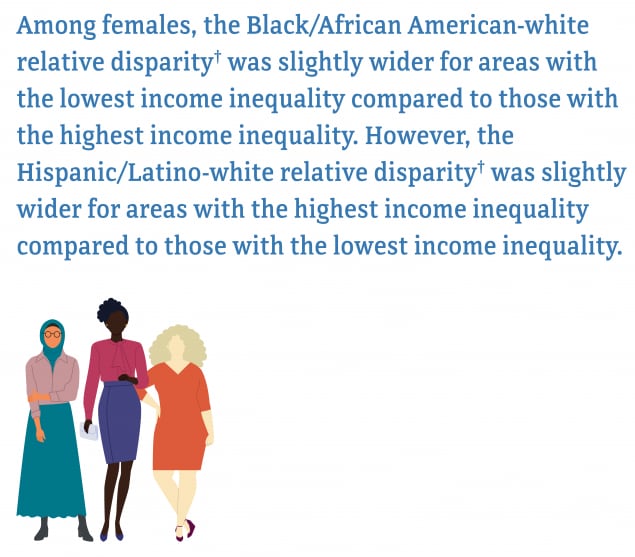
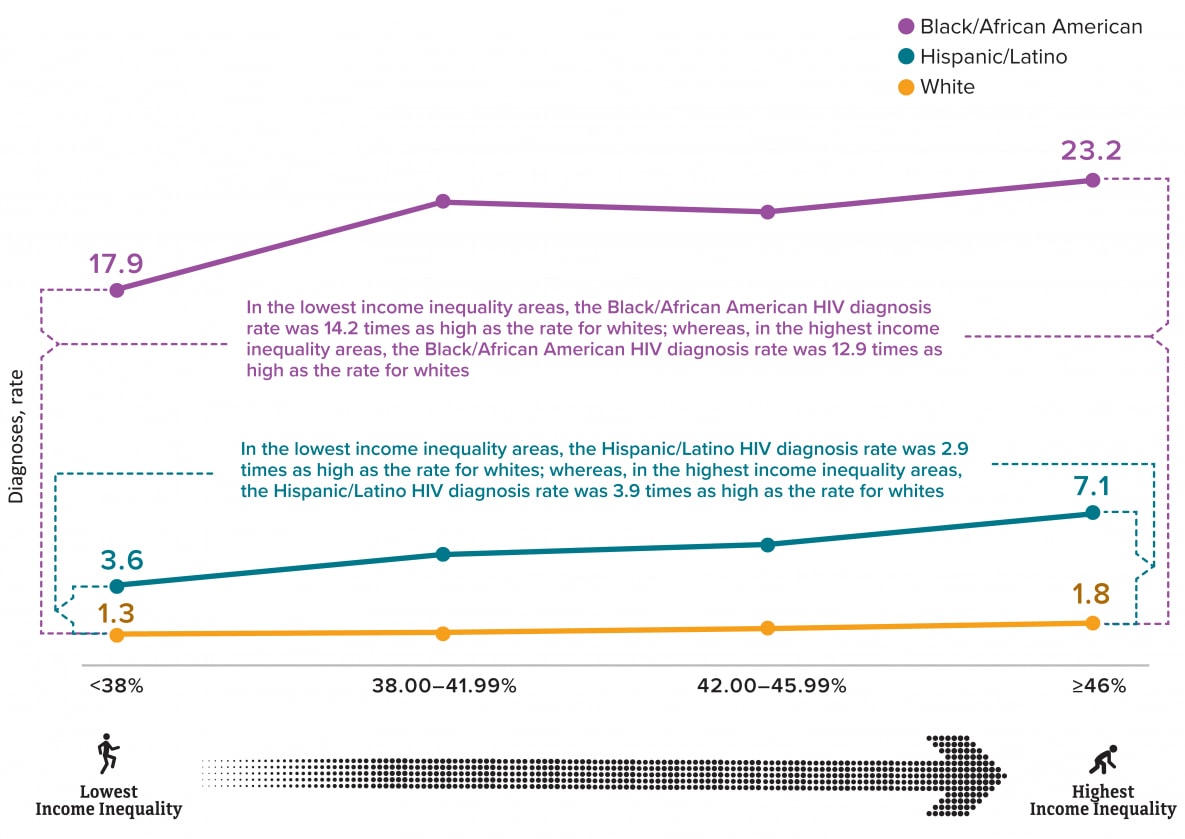
†relative disparity measures the ratio of the difference between the group rate and the overall population rate to the overall rate.
Health Disparities Special Considerations
Accurate and timely assessment and monitoring of the magnitude and direction of change of health disparities and their determinants are necessary for evaluation of progress toward the Healthy People 2030 goal of eliminating health disparities, achieving health equity, and attaining health literacy to improve the health and well-being of all [7]. Increasingly, overall health disparities are not improving in the United States [8]. Evidence from systematic reviews suggests that downstream prevention interventions (directed at individual-level factors) are more likely than upstream interventions (directed at social or policy-level factors) to increase health disparities [8].
Below are some important upstream factors, that can lead to downstream and upstream interventions, for special consideration in addressing health disparities related to poverty, education, income, and healthcare status among adults with diagnosed HIV infection.
Residential Segregation
The persistence of racial differences in health, after individual differences in socioeconomic status (SES) are accounted for, may reflect the role that residential segregation and neighborhood quality can play in racial disparities in health. As a result of segregation, higher income Blacks/African Americans live in lower income areas than whites of similar economic status, and lower income whites live in better areas than lower income Blacks/African Americans [9]. Other racial/ethnic groups are less segregated than Blacks/African Americans, and although residential segregation is inversely related to income for Hispanic/Latinos and Asians, the segregation of Blacks/African Americans is high at all levels of income [9]. Blacks/African Americans with the highest levels of income experience more residential segregation than Hispanics/Latinos and Asians with the lowest levels of income [9]. In addition to other SDH variables, residential segregation may play a role in racial disparities in HIV diagnoses by isolating individuals from access to important resources and affecting neighborhood quality, with lower income and isolated areas being more vulnerable [10].
Medical Treatment
Hispanics/Latinos account for the largest uninsured group in the United States [11], and one-quarter of Hispanic/Latino adults do not have a primary care provider [12]. Additionally, Blacks/African Americans typically have the lowest linkage of HIV medical care [13]. Blacks/African Americans and Hispanics/Latinos are less likely than whites to receive appropriate medical treatment after they gain access to medical care. These patterns exist across a broad range of medical procedures and institutional contexts, and they are further compounded by factors like stigma, immigration status, discrimination—all of which may contribute to disparities in HIV infections [14].
Psychosocial Stress
Exposure to psychosocial stressors (i.e., stress that may result from poverty, crime, racial discrimination, or other persistent difficulties) may be another way SES and race/ethnicity are linked to health. Chronic exposure to stress is associated with altered physiological functioning, which may increase risks for a broad range of health conditions. Individuals in lower income areas are more likely to report elevated levels of stress and may be more vulnerable to the negative effects of stressors [9]. In addition, the subjective experience of discrimination is a neglected stressor that can adversely affect the health of minorities. Discrimination may contribute to the elevated risk of disease that is sometimes observed among Blacks/African Americans [9]. Psychosocial stress may play a role in racial disparities in HIV diagnoses by altering physiological functions due to the additional chronic exposure to stress among individuals in lower income areas and experiencing discrimination [9].